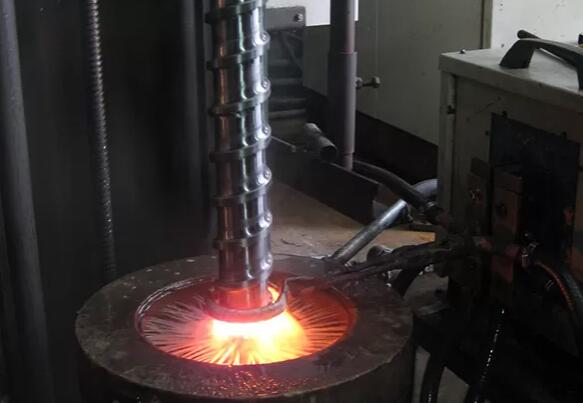Oct. 14, 2025
Principle of induction hardening
Induction heating surface quenching is a heat treatment process that uses electromagnetic principles such as electromagnetic induction, skin effect, eddy current and resistance heating to rapidly heat and cool the surface of the workpiece.
During induction heating surface quenching, the workpiece is placed in an inductor made of a copper tube. When alternating current of a certain frequency passes through the inductor, the workpiece in the alternating magnetic field generates an induced current. Due to the skin effect and eddy current, the high-density alternating current on the surface of the workpiece generates resistance heat, which quickly heats the surface of the workpiece and quickly reaches the quenching temperature. Then water is sprayed to cool it down, and the surface of the workpiece is hardened.
During induction heating, the distribution of the induced current on the workpiece cross section is related to the current frequency. The higher the current frequency, the stronger the skin effect, the thinner the surface where the induced current is concentrated, and the thinner the depth of the heated layer and the depth of the hardened layer.
Surface heat treatment is a method of changing the surface structure of a part to obtain a very high hardness martensite while retaining the toughness and plasticity of the core (i.e. surface quenching), or simultaneously changing the chemical composition of the surface to obtain corrosion resistance, acid resistance, alkali resistance, and a surface hardness higher than the former (i.e. chemical heat treatment).
Induction hardening: Induction heating is extremely fast, only a few seconds or more than ten seconds. The martensitic structure of the quenched layer is fine and has good mechanical properties. The surface of the workpiece is not easily oxidized and decarburized, and the deformation is also small. In addition, the depth of the hardened layer is easy to control, the quality is stable, and the operation is simple, which is particularly suitable for mass production . It is commonly used for medium carbon steel or medium carbon low alloy steel workpieces, such as 45, 40Cr, 40MnB, etc. It can also be used for high carbon tool steel or cast iron parts. Generally, when the depth of the hardened layer of the parts is about 1/10 of the radius, a good combination of strength, fatigue resistance and toughness can be obtained. Induction heating surface quenching is not suitable for workpieces with complex shapes because the inductor is difficult to make.
 Table 1-1 Induction heating types and application ranges
Table 1-1 Induction heating types and application ranges
Induction heating type | Common frequencies | General hardened layer depth / mm | Application |
high frequency | 200~1000kHz | 0.5~2.5 | Small and medium module gears and small and medium sized shaft parts |
intermediate frequency | 1~10kHz | 2~10 | Larger shafts and large and medium module gears |
Super Audio | 30~36kHz | The hardened layer can be distributed along the contour of the workpiece | Small and medium module gears |
Power frequency | 50Hz | 10 to 20 | Penetration heating of larger diameter parts, surface quenching of large diameter parts such as rollers and train wheels |
Advantages of induction hardening machine
1. The surface hardness is 2-3HRC higher than that of ordinary quenching, and has lower brittleness:
2. Fatigue strength and impact toughness are improved, and the general workpiece can be improved by 20-30%:
3. Small deformation:
4. The depth of the quenching layer is easy to control:
5. Not easy to oxidize and decarburize during quenching:
6. Cheaper low hardenability steel can be used:
7. The operation is easy to mechanize and automate, with high productivity
8 The higher the current frequency, the thinner the hardened layer.
The principle of flame quenching
Flame surface quenching : The flame of a mixture of acetylene-oxygen or coal gas-oxygen is sprayed onto the surface of the part to heat it quickly. When the quenching temperature is reached, it is immediately cooled by spraying water or emulsion.
The depth of the through-hardening layer is generally 2-6mm. Too deep a depth will often cause serious overheating of the part surface and easily produce quenching cracks.
Surface hardness: steel can reach HRC65, gray cast iron is HRC40-48, alloy cast iron is HRC43-52
This method is simple and does not require special equipment, but it is prone to overheating and the quenching effect is unstable, which limits its application.
Suitable for single-piece or small-batch production of large parts and tools or parts that require local quenching, such as large shafts, large module gears, etc.
Commonly used steels are medium carbon steels, such as 35, 45, and medium carbon alloy structural steels (alloying elements <3%), such as 40Cr, 65MN, etc. They can also be used for gray cast iron and alloy cast iron parts.
Carbon content % Recommended article:1.1kW Thruster vs. Traditional Systems: Enhancing Yacht Stability | Heat treatment method | Torsional bending fatigue strength |
0.33 | High-frequency surface quenching | 600 |
0.33 | Flame surface quenching | 350 |
0.33 | Overall heating and quenching in an electric furnace | 90 |
0.41 | High-frequency surface quenching | 600 |
0.41 | Overall heating and quenching in an electric furnace | 110 |
0.41 | Normalizing | 130 |
0.63 | High-frequency surface quenching | 360 |
0.63 | Flame surface quenching | 390 |
0.63 | Overall heating and quenching in an electric furnace | 150 |
69
0
0
All Comments (0)
Previous: 1.1kW Thruster vs. Traditional Systems: Enhancing Yacht Stability
Next: Solving Common Buyer Concerns for 5 Ton Pyrolysis Plants
If you are interested in sending in a Guest Blogger Submission,welcome to write for us!
Comments